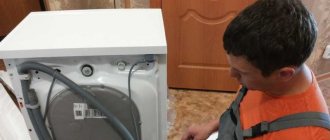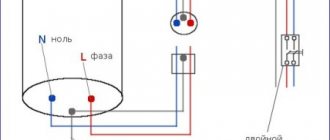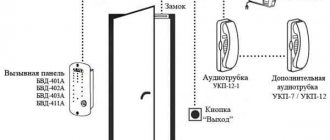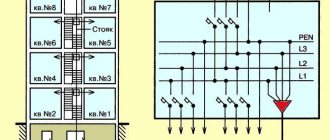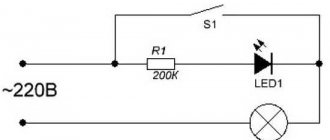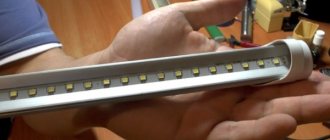General recommendations
block connection diagram
It is worth keeping in mind that the electrical connection diagrams for the air conditioner for low-power household and more powerful semi-industrial (commercial) models differ. The former have single-phase, and the latter both single-phase and three-phase connections.
There are two ways to power a split system: directly through an outlet and by connecting a wire to the electrical panel. The first option is suitable for household appliances and in the case of already completed renovations in the room. The second method is acceptable for powerful units, as well as for devices of various capacities at the initial stage of rough repair work. Household models are often put into operation using the first method, so this article will discuss this in more detail.
As a rule, powering a split system takes place in several stages, which should be strictly followed if the user plans to do this independently. So, how to connect an air conditioner with your own hands without relevant experience? It's difficult, but quite doable.
Sequence of work
First of all, the owner of a split system must remember the sequence of work. They are carried out according to the following scheme:
- preparation of materials and tools;
- study of air conditioner connection diagrams;
- laying interconnect cables - connecting them to the terminals of the indoor and outdoor units of the air conditioner;
- connecting the device to the network;
- checking the operating parameters of both modules.
Depending on the indoor unit, the cable may run from either the outdoor unit or the indoor unit to the power source.
Connection and connection of air conditioner interconnect cables
terminal block with wires
If you decide to connect the air conditioner to the electrical network through a socket, you need to make sure that it can withstand the upcoming load. If the required parameters do not comply, the installer should not connect the device to it and must explain to the customer the essence of the problem, as well as offer a way out - laying a separate line to the panel.
Here are the basic requirements for the outlet:
- The socket must have a ground connection or a differential relay;
- It must correspond to the required values specified in the instructions for the split system. The best ratio is high network power and low cooling device power;
- The air conditioner is not placed in line with other powerful appliances;
- It is forbidden to power the device from an outlet if aluminum wiring is used. To connect the air conditioner through it, you need to take a copper wire with the appropriate cross-sectional area;
- It is important to make sure that the socket itself is connected through a circuit breaker that has a distance between contacts of at least 3 mm when open;
- Work must be performed by an experienced installer in accordance with required national and local standards.
If all of the above requirements are met, begin preparatory work on connecting the air conditioner to the outlet with your own hands. First, check that you have the necessary tools, and then strip the cable cores with a knife or an insulation stripper. Now we move on to laying interconnect cables and connecting the external unit of the air conditioner, and then the internal one.
Modern reinforced euro sockets are usually suitable for high-power devices.
The connection is carried out according to the diagrams on the blocks, which indicate the terminal blocks corresponding to the interblock cables. Unconnected cable cores must be insulated so that they do not come into contact with live parts of the air conditioner.
Marking of terminals for on/off models of split systems:
- 1 – compressor power supply;
- 2(N) – common neutral;
- 3 – four-way valve;
- 4 – fan of the external unit;
- (Earth).
Terminal markings for inverter models of split systems:
- 1 – food;
- 2(N) – neutral;
- 3 – control;
- (Earth).
In some Chinese economy-class air conditioners, a separate wire is laid between the units to connect a temperature sensor.
The wires are connected to the terminals. The terminal box is located under the block panel. In accordance with the numbering, the wires of the internal module are connected to the contacts of the external module.
Stages
Brief instructions for connecting an air conditioner with your own hands for the indoor unit are as follows:
- Remove the decorative panel from the block.
- Remove the protective cover from the connectors and the cord clamp.
- Lay the interconnect cable through the mounting hole in the rear of the device.
- Prepare the cable for connection by first stripping it and removing the insulation.
- The stripped ends are inserted into the terminals and tightened tightly with screws. The tightening force should be approximately 1.2 Nm. Typically, terminal blocks use screw terminals to connect wires.
- The clamps secure the interconnect wire well.
- Reinstall the terminal cover.
The same brief instructions are suitable for connecting the external unit of the air conditioner according to the electrical diagram yourself. Instead of a decorative panel, remove the protective cover from the outdoor unit and connect it with wires to the indoor module through terminals.
At the very end, they check whether the work done corresponds to the connection diagrams. Only then can you turn on the device.
The internal structure of the air conditioner and the principle of its operation
Before installing an air conditioner in a house or apartment, you must become familiar with the operating principle of this device, as well as its structural structure. This knowledge will not only speed up installation work, but also perform it correctly.
The air conditioner consists of a compressor and an evaporation unit connected to each other by tubes
Split systems consist of an evaporator unit and a compressor. These elements are connected to each other by tubes. To mount the external unit or compressor, the plane of the outer wall is used, and the evaporator is placed indoors. Expensive models of climate control equipment may have several indoor units. All of them are connected to one compressor.
Operating principle of split systems:
- Under the influence of high pressure, refrigerant is supplied through the nozzle into the evaporator chamber.
- There the working substance expands and boils. The vapors formed during this process absorb heat.
- As a result of this process, water condensate is formed, which settles on the radiator in the evaporation unit.
- From there, the moisture enters a special tank and is removed from the room through a tube.
During operation of the air conditioner, the following occurs with the working substance:
- The compressor pumps out vapors and increases the pressure.
- The working substance is heated, which changes from a liquid state to a gaseous state.
- In the form of a dense fog, the refrigerant enters the condensate collection chamber.
- The fan cools the condensate vapor, which again turns into a liquid state.
- Then the working substance, driven by pressure, again enters the evaporator nozzle. The cycle repeats.
To install everything correctly, you should have an understanding of the structure and operating principle of the air conditioner
The efficiency of climate control equipment, as well as electricity consumption, depend on the conditions under which the air conditioner operates. If a heating device is installed nearby, electricity consumption will increase.
Note! If you want to install an air conditioner in an apartment, you must take into account the position of the heating devices. Their close proximity increases the load on climate control equipment, which can cause it to fail.
Selection of wire for connection
five-core copper wire
It is worth remembering what wire is needed to connect the air conditioner, or rather, what cross-section is required. Its parameters are indicated in the instructions for each split system model individually. The cross section depends on the power of the device. As a rule, household air conditioners (sizes 7, 9, 12, 13) require a wire diameter of 1.5 to 2.5 mm². You can focus on the current strength: less than 18 A - 1.5 mm², more than 18 A - 2.5 mm².
Also, the wire required to connect the air conditioner to the electrical network is selected taking into account the distance of the panel. The distance between the device unit and the electrical panel over 10 meters requires a cross-section of 2.5 mm².
To ensure reliable operation of the air conditioner, only copper wires are used. For a single-phase connection, three-wire wires are used (phase-neutral-ground), and for a three-phase connection, five-wire wires are used.
interconnect cable attached to the outdoor unit
The wire should not be laid near gas and heating pipes. The minimum distance between them is at least 1 meter. If necessary, use additional insulation. As a rule, the cable is laid along with the route in a corrugation and hidden in a box or groove in the wall.
The cables are attached to the wall with clamps, which are secured with dowels or screws. When laying communications in boxes, glue or screws are used to secure them. If hidden wiring is performed, then the wires are hidden in a corrugation and fixed to the wall using special clamps.
Review of the design of the indoor unit, installation of the air conditioner: diagram and structure
The indoor unit is placed indoors, so manufacturers pay great attention to its appearance. The split system must fit into the interior design. In addition, the size of the indoor unit of the air conditioner is of great importance. Its width varies between 0.7-1.6 m, its depth can be from 16 to 20 cm, and its height can be from 20 to 32 cm.
The indoor unit consists of the following components:
- front panel;
- coarse and fine filters;
- evaporator;
- fan;
- horizontal and vertical blinds;
- indicator panel;
- control boards;
- condensate collection pan;
- fitting connections.
The front panel looks like a plastic grille. It provides air access to the block. The coarse filter traps large particles of dust, debris and animal hair. It is a plastic mesh that needs regular cleaning (at least 2 times a month). Fine filters come in two types. Coal types of products are aimed at removing unpleasant odors, while electrostatic ones remove plant pollen and fine dust from the air.
The air conditioning system must fit into the interior design
The indoor unit has a three- or four-speed fan. The evaporator is essentially a radiator where the cold working substance is heated and turns into a vapor state. The air flows that pass through this element, on the contrary, are cooled.
Horizontal blinds control the movement of air vertically. They are equipped with an electric drive. Their position is adjusted using the remote control. Horizontal blinds are capable of automatically performing oscillatory movements, as a result of which the cooled air is evenly distributed throughout the room. The indicator panel is located on the front side of the split system. It is a set of light indicators that allows you to determine in what mode the air conditioner is operating. In addition, LEDs indicate breakdowns.
Water collects in a tray located under the evaporator and is discharged outside using a drainage hose. The control board consists of an electronics unit and a microprocessor. Union connections are used to connect pipes between the external and internal units. Vertical blinds control the horizontal movement of air.
Note! The position of vertical blinds is manually adjusted. Only some models of premium split systems have the ability to configure using a remote control.
The indoor unit is a technically complex device consisting of many elements
Circuit breaker
If you plan to power the split system from the panel, then you will need protection devices, one of which is a circuit breaker. It is selected relative to the rated power of the device indicated in the technical data sheet or on the external unit. It is advisable to always leave a small reserve. For example, start-stop air conditioners have a very high starting current, exceeding 20 A. And although the operating time at such values is short, it is still worth taking this into account.
You can select the required current values of the machine using the formula: divide the air conditioner power (kW) by the network voltage (220 V) and increase the obtained data by 20-30%.
When connecting the air conditioner to the power supply, it is important to remember that the circuit breaker must have a distance between the contacts in the open state of at least 3 mm for each phase wire. The phase order is strictly observed: the order of connecting the phases must correspond to the order on the terminal block.
A type C circuit breaker is suitable for air conditioners. It completely ensures the safety of the motor load and has high tripping characteristics in case of emergency.
You need to make sure whether the electrical panel allows you to install additional equipment in it.
It is worth remembering that for both the air conditioner and other household electrical appliances, the most reliable connection is via a separate line. With this option, it is not necessary to install a residual current device and a differential relay.
Connecting the LG ART COOL GALLERY air conditioner according to electrical diagrams
The photo below shows an electrical diagram for connecting an LG ART COOL GALLERY inverter type air conditioner. The first diagram is for connecting the indoor unit, the second is for connecting the outdoor unit. The third photo is the terminal block of the external unit. The fourth photo is a completely ready-to-function indoor unit. The model 9 split system shown in the photographs is installed in the apartment, connected to an outlet and works perfectly. The installers used a copper power cable with a cross-section of 1.5 mm².
In order to cope with all the stages yourself, you can watch the video of installing and connecting the air conditioner with your own hands below:
Diagram of the refrigeration circuit of the external unit of the split system
- Compressor. Compressor. It works with refrigerant, it compresses freon and circulates it through the system.
- Heat exchanger. Heat exchanger. There are two of these devices in the system: one is for the external unit, in which the refrigerant is cooled to a temperature below the dew point, the other is for the internal unit, this is an evaporator, where the working fluid evaporates and gives off temperature.
- 2 Way valve. Expansion 2-way valve with two positions: closed and open.
- 3 Way valve. Thermostatic 3-way valve, it is a service port; hoses are connected to it when filling with freon or measuring pressure in the system.
- 4 Way valve. Expansion 4-way valve, which provides reverse movement of the refrigerant in heating mode.
- Strainer. A filter that prevents moisture from entering a thin channel, as it can clog it and make it inaccessible to the working environment.
- Muffler. This is a muffler.
The solid arrow in the diagram shows how the device operates in cooling mode, the dotted arrow in heating mode. In more complex air conditioners, in addition to the mechanisms described above, the following can be installed: oil separators, pressure sensors, an injection device into the compressor, liquid freon separators and restart lines.
